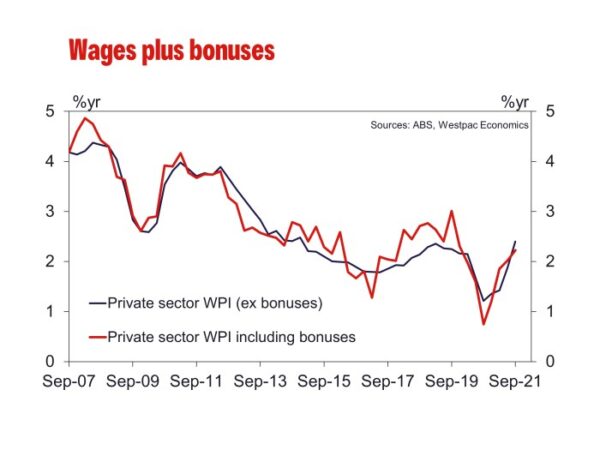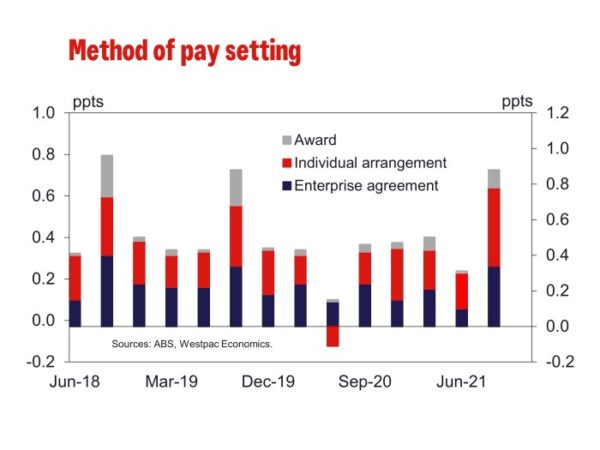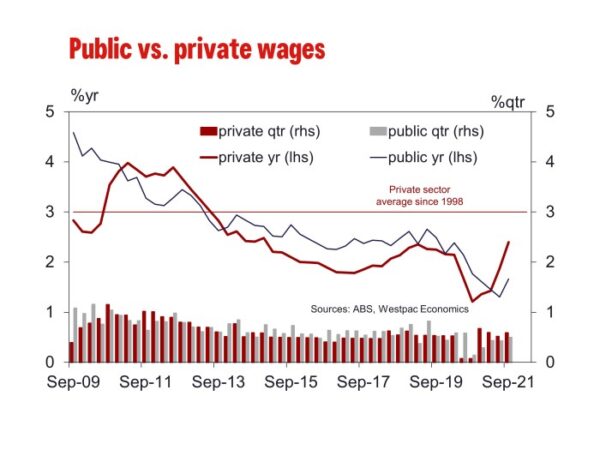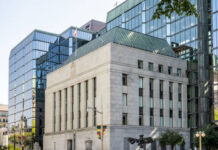The Q3 Wage Price Index (WPI) lifted 0.6%qtr/2.2%yr. Wages are lifting in sectors with tight labour markets but yet to spread more widely.
- The WPI lifted 0.6% in the September quarter, a bit strong than Westpac’s 0.5% forecast of 0.5% but spot on the market’s 0.6% estimate. This followed a modest 0.4% gain in Q2 which surprised us given it followed two solid 0.6% quarterly increases but, to be fair, those increases were a bounce back from the two softest quarters (0.1% in Q3 2020 and 0.2% in Q2 2020) in the history of the series.
- With the base effects of those two soft quarters dropping out the annual rate lifted to 2.2%, the fastest pace since Q3 2019.
- While slightly higher than Westpac’s expectations this number is just return to pre-Covid rates where wages were underperforming economic activity and so sit sits comfortably within the RBA’s view on wages.
- The ABS noted that the quarterly gain was due to wage and salary reviews around the end of the financial year, scheduled enterprise agreements and annual award rises.
The 0.6% increase in private sector wages the ABS described as being in line with pre-pandemic September outcomes. With base effects the annual pace of private sector wages lifted 0.5ppt to 2.4%yr, the fastest pace since March 2019. The ABS noted more employers conducting salary reviews than observed at the same time last year, when COVID-19 had a bigger influence on business operations. Small, isolated pockets of demand across a number of industries saw larger increases paid to attract and retain experienced staff.
There has been a lot of press lately of bonus being paid to entice experienced workers by various employers. However, the private sector with bonuses series (seasonally adjusted by Westpac) also lifted 0.6% to be up 2.2%yr. It appears that the use of bonus are, at this stage, not as widespread as reported.  Public sector wage increases improved with a 0.5% gain, the largest quarterly increase since June 2020, lifting the annual pace to 1.7%yr from 1.3%yr (a record low). The ABS noted that this quarter saw a return to regular scheduled increases after a period of public sector wage freezes.
Public sector wage increases improved with a 0.5% gain, the largest quarterly increase since June 2020, lifting the annual pace to 1.7%yr from 1.3%yr (a record low). The ABS noted that this quarter saw a return to regular scheduled increases after a period of public sector wage freezes.
The following data has been seasonally adjusted by Westpac.
The sector with the strongest rise in wages was construction up 1.0% in the quarter (2.6%yr) which was the strongest quarterly print since December 2012. The next strongest was professional, scientific & technical services at 0.9% and as this sector has been running ahead of the average the annual pace lifted to 3.4%.
Retail trade had the weakest gain of just 0.1% but due to base effect of the weakest quarters rolling out the annual pace lifted from 1.6%yr to 2.1%yr.
In the June quarter we were disappointed that the improvement in the Victorian labour market was yet to be reflected in an improvement in wages there. There was a turn around in the September quarter with wages lifting by 0.8% in that state for a 2.5%yr pace. Wages lifted 0.6% in NSW (2.1%yr) and 0.5% in Qld (2.0%yr).
Individual bargaining arrangements are the most responsive to economic conditions and even saw wages decline in June 2020. Of the 0.9% in the original (not seasonally adjusted) rise in the September WPI 0.44ppt came from individual arrangements, 0.34ppt via enterprise agreements and just 0.1ppt from awards. At this stage individual arrangements are not running that much stronger than enterprise agreements suggesting we are just getting back to pre-Covid wages inflation which at 2.0%yr to 2.4%yr is still well short of the RBA goal of 3%yr.
 While wages have indeed lifted in industries where labour shortages are more pronounced, we are yet to see broader wage gains. What will be critical is how higher wage outcomes in these sectors, via individual bargaining arrangements, spread to the minimum wage and enterprise bargaining. In 2021 the increase in the minimum wage was 2.50%, up from 1.75% in 2020 but still less than 3.0% in 2019 and 3.5% in 2018. We suspect that in 2022 the minimum wage outcome is likely to be closer to the 2018 outcome than 2019. At this stage enterprise bargaining yet to show a meaningful lift but it should soon appear in any construction agreements being negotiated.
While wages have indeed lifted in industries where labour shortages are more pronounced, we are yet to see broader wage gains. What will be critical is how higher wage outcomes in these sectors, via individual bargaining arrangements, spread to the minimum wage and enterprise bargaining. In 2021 the increase in the minimum wage was 2.50%, up from 1.75% in 2020 but still less than 3.0% in 2019 and 3.5% in 2018. We suspect that in 2022 the minimum wage outcome is likely to be closer to the 2018 outcome than 2019. At this stage enterprise bargaining yet to show a meaningful lift but it should soon appear in any construction agreements being negotiated.













